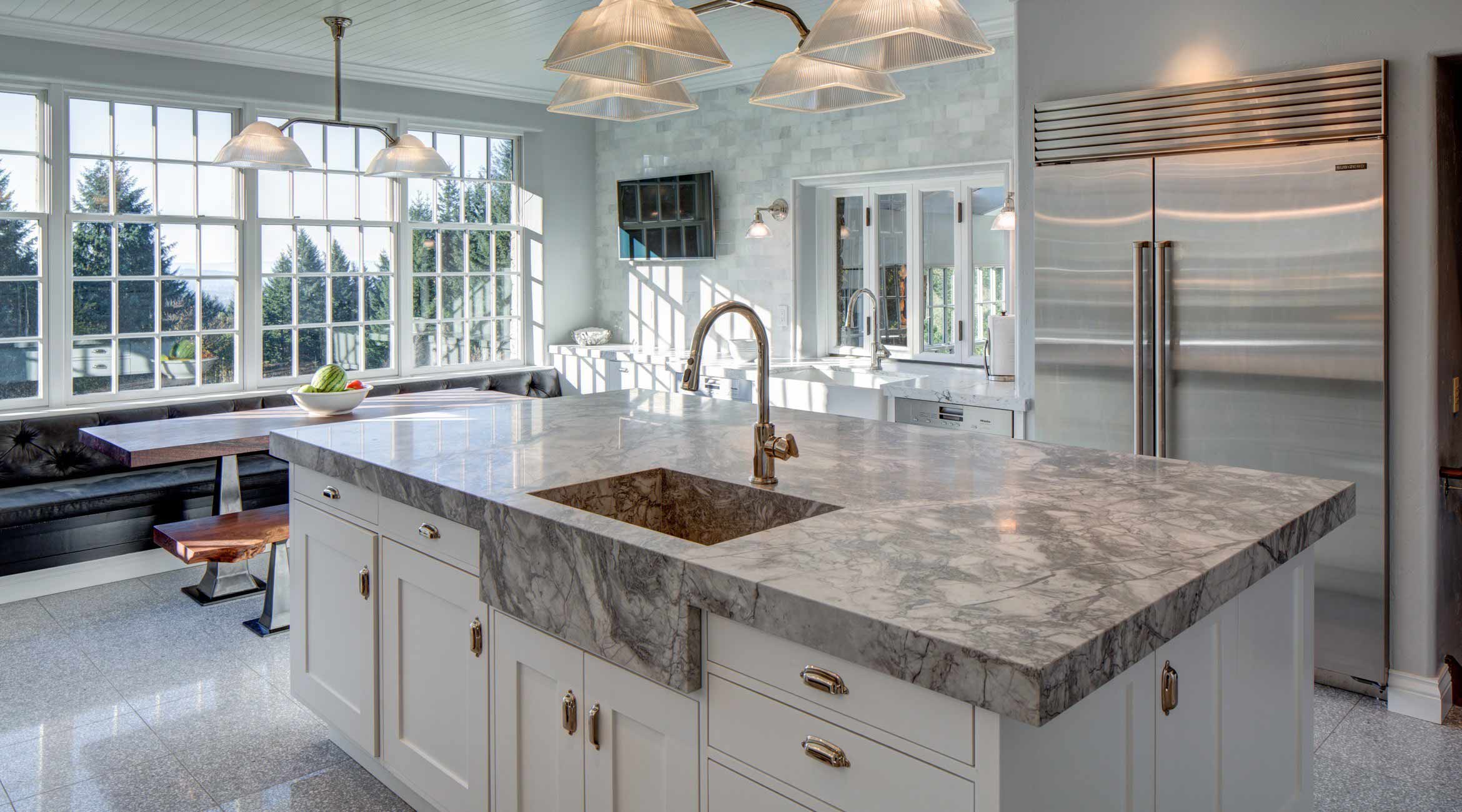Selecting A Beautiful & Functional Countertop
Over the past several decades, the countertop industry has radically changed. In the 1970s, countertops were simply seen as work surfaces: a place to chop vegetables, do homework or use to get ready for the day. Today, countertops are seen as design elements that contribute to the overall aesthetic of the home. And since countertop trends and customer preferences are constantly changing, companies must work hard to stay on the cusp of innovation.
There’s no one countertop that’s ideal for every homeowner. The best material for your kitchen will depend on several factors, including color, overall style, durability, stain- and scratch-resistance, and, of course, price. Below are the most popular countertop options available today.
NATURAL STONE
The most common natural stones used to make countertops include granite, soapstone and slate. Here’s a brief look at each material:
Granite, once found only in expensive, high-end kitchens, is more commonplace today and is by far the most popular natural-stone countertop material. Granite counters are sold primarily through local fabricators, but they’re also commonly available at many home-improvement stores and kitchen showrooms.
Soapstone and slate both come in far fewer colors than granite. Soapstone is usually dark greenish-black, although lighter green-gray slabs are also common. Slate is an extremely dense stone that comes in five subtle colors: green, red, gray, purple and black. Slightly less common are variegated purple and mottled purple slates, which have visible veins and shades of contrasting colors. Both soapstone and slate can be fabricated into sinks to match the countertop.
Slate has a soft-matte sheen, but you can create a “wet” look by rubbing the surface with lemon oil. Slate countertops cost roughly $150 to $200 per square foot, depending on the fabrication. Soapstone is priced comparably with mid-range granite: $100 to $150 per square foot.
SOLID SURFACE
Solid-surfacing materials — such as Corian, Staron and Wilsonart— are made of 100 percent acrylic, 100 percent polyester, or a combination of acrylic and poly. They’re highly stain- and scratch-resistant, and completely renewable and repairable. Scratches and burns can be sanded out; deep gouges can be filled. Seams are fused together to create undetectable joints. And the material comes in literally hundreds of colors and patterns, many of which resemble natural stone. Solid-surface sinks are also available to either match or contrast the countertop.
QUARTZ COMPOSITE
Another type of solid surfacing material that’s worth considering is quartz composite. Also known as engineered stone, this unique material is composed of about 90 percent quartz and 10 percent acrylic or epoxy binder. DuPont Zodiaq, Formica Solid-Surfacing and Silestone are a few of the many quartz composites now available.
The main differences between engineered stone and traditional solid-surfacing materials are that engineered stone is much harder and has a depth, clarity and radiance not found in other solid surfaces. Quartz composites cost slightly more than traditional solid surfaces, but both materials are comparable to high-end granite: Expect to pay $200 to $350 per square foot for a solid-surface counter.
PLASTIC LAMINATE
Plastic laminate, which is often referred to by the tradename, Formica — is a surprisingly durable material that can survive many years in the toughest kitchens, which is impressive when you consider that plastic laminate is made primarily of kraft paper impregnated with resins.
Plastic laminate is available in hundreds of colors, dozens of patterns and various textures. However, only those with a matte or fine-matte finish should be used for countertops. Never use a textured laminate for a kitchen counter; its raised ridges will start to show wear rather quickly. Be aware, too, that there are two basic types of laminates: 1/16-inch-thick general-purpose and 1/32-inch vertical grade. Only general-purpose laminate is suitable for countertops; vertical grade is for backsplashes, and cabinet doors and drawer faces.
TILE
The trend in kitchen design for the past decade or so has shifted toward low-maintenance, seamless counters. As a result, fewer countertops are covered with ceramic or porcelain tile. However, that doesn’t mean you should totally discount tile for your kitchen. Tile is an excellent choice for backsplashes, or for secondary work surfaces, such as islands, eat-at counters, peninsulas, wet bars or butler’s pantries. Just be sure to use tiles rated for use on floors or countertops. Never use wall tile on a counter. It’s too thin and will easily crack.
WOOD
Wood is another traditional countertop material that has lost prominence over the years due to the widespread popularity of granite and solid surfaces. And again, the reason is maintenance. It’s hard to beat the natural beauty and warmth of wood, but maintaining the surface requires more of a commitment than most busy homeowners are willing to make. But, just like ceramic tile, there are secondary surfaces where using wood makes sense, such as a baker’s prep area, eat-at counter and food chopping block. In fact, wood is the only countertop material recommended for cutting, slicing, and chopping.
CONCRETE
Concrete counters, which closely resemble slabs of natural stone, are becoming increasingly more popular. Unlike the concrete counters of the late-1980s, which were messily poured atop the cabinets, today’s fabricators offer pre-cast counters that are made in a workshop and delivered—fully cured and finished—to the jobsite.
